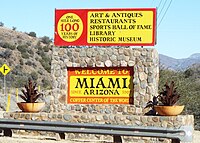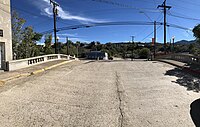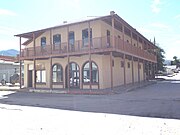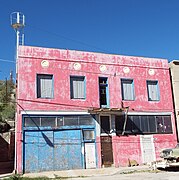List of historic properties in Miami, Arizona
List of historic properties in Miami, Arizona | |
|---|---|
 Welcome to Miami, Arizona |
| Part of a series of the |
| Cities, towns and CDPs in Arizona with lists and images of historic properties, forts, cemeteries or historic districts |
|---|
This is a list which includes a photographic gallery, of historic structures, some which are listed in the National Register of Historic Places, of significance in Miami, Arizona, a mining town. Miami was founded by Cleve W. Van Dyke in 1907 and is located on the northeastern slope of the Pinal Mountains, between the towns of Superior and Globe on U.S. Routes 60.
Brief history


The area surrounding the Pinal Mountains and where the present day town of Miami in Arizona is now located, was inhabited by the Tonto Apache Tribe. Silver mining started the initial move into the Miami region in the late 1860s. The Apaches would sometimes raid the settlements of the Anglo-Europeans and steal their live stock.
On January 27, 1864, a group of settlers under the leadership of King S. Woolsey decided to confront the Apaches, with the help of Maricopa Warriors, and retrieve their live stock. They went deep into Apache territory in the Pinal Mountains and soon found themselves surrounded by the hostile Native Americans. Twenty four (24) Apaches and one Anglo were killed in what became known as the "Bloody Tanks Massacre". The Bloody Tanks Wash was named after the Bloody Tanks Massacre since it was said that the red Apache blood filled stream in the wash. This is the stream that would bisect the future town of Miami.[1]
The price of Silver prices began to drop while the price of Copper increased. The Miami Copper Company was established and the mining town flourished. Though the town was officially founded in 1907, by Cleve W. Van Dyke, it wasn't until after 1908 that miners, businessmen and entrepreneurs began to take an interest in settling there.[2]
Cleve W. Van Dyke was a local businessman and entrepreneur who purchased land from the Miami Land and Improvement Company. He came up with the idea of celebrating “Miami Townsite Day” October 11, 1909. With the help and support of real estate companies in Globe, Van Dyke organized several events and was able to create a state of enthusiasm among the public for the townsite day. Thus, he did not have any problems in selling many of his land lots.←[3] Van Dyke is considered to be the founder Of Miami.[2]
Eventually, the Phelps Dodge Corporation bought out the Miami Copper Company and took over the day-to-day operations of the mine. Finally the Freeport-McMoRan then bought Phelps Dodge and continues the daily operations of the mine.[3]
Historic buildings pictured






Miami has various properties listed in the National Register of Historic Places. Among these properties are five Luten arch concrete bridges built by the Topeka Bridge & Iron Co. over the Bloody Tanks Wash. They are the Miami, Inspiration, Keystone, Cordova and Reppy Avenue bridges. All the bridges were built in 1918, with the exception of the Reppy Ave. bridge which was built in 1921.
- The Miami Ave. Bridge - Listed in the NRHP on March 31, 1989 Ref. #88001693.[4]
- The Inspiration Ave. Bridge - Listed in the NRHP on March 7, 1989 Ref. #88001691.[4]
- The Keystone Ave. Bridge - Listed in the NRHP on March 7, 1989 Ref. #88001692.[4]
- The Cordova Ave. Bridge - Listed in the NRHP on March 7, 1989 Ref. #88001690.[4]
- The Reppy Ave. Bridge - Listed in the NRHP on September 30, 1988, Ref. #88001689.[4]
- The Keystone Stairs - Built in 1910 on Keystone Ave.
- The Unique Theatre - Built in 1915 and located at 522 Sullivan Street.
- The Gila Valley Bank and Trust Co. - Built in 1910 and located at 500 W, Gibson St.
- The Bullion Plaza School - The school was built in 1923 and is located at 150 Plaza Circle. It is historically important for its association with the history of Mexican Americans and school segregation in Arizona. The school was listed in the National Register of Historic Places on January 4, 2001, Ref. #00001591. The building now houses the Bullion Plaza Cultural Center & Museum.[5]
- The Wilton's Paint and Wallpaper building - Built in 1912 and located at 123 N. Miami Avenue.
- The 'Gem Theatre' - Built in 1915 and located at 520 Sullivan Street.
- The Soderman Building - Built in 1917 and located on 198 Chrisholm Ave. The building was listed in the NRHP on May 11, 2000 Ref. #0000465.The Soderman building was originally constructed as a two-story frame building. It was converted to concrete construction and housed a bar on the ground floor and a rooming house for Scandinavian miners on the top floor.[6]
- Our Lady of the Blessed Sacrament Church - The church, which originally called "Our Lady of Mt. Carmel" was built in 1917 and is located at 844 Sullivan Street. It was listed in the National Register of Historic Places on January 8, 2008, Ref. #07001332.[7]
- YMCA Building - built in 1917 and located at 155 North Miami Ave.[8]
- Commercial Building - built in 1916 and located 143 N. Miami Ave.
- Miami Community Church - The structure was built in 1920 and is located at 305 Live Oak Street. It was listed in the National Register of Historic Places on March 15, 2005, Ref. #05000137. The building is now occupied by the Divine Grace Presbyterian Church.[9]
- The Fritzpatrick Building - The structure was built in 1909 was the first building in Miami. It is located at 53 Keystone Ave. It was also, the first poured concrete building in Miami.[10]
- Kelly's Photography Building - The structure was built in 1911 and is located at 517 Sullivan Street. Roy F. Kelley, his wife, Mary E. Mallarky and her brother, Andrew J opened their photography studio in 1914. It now houses the Joshua's Tree House Antique Store.[11]
- Price Brothers Building - The structure was built in 1913 and is located at 508 Sullivan Street. Ray Price, the owner of the building had a meat market there.[12]
- The Travelers Hotel - The hotel was built in 1918 and is located at 621 Sullivan Street. One of the first hotels to be built in Miami.[12]
- Firehouse Building - The first firehouse of Miami was built in 1915 and is located 422 Gibson Street.[12]
- First Baptist Church Building - The structure located at 534 Gibson Street was built in 1915 and is now in a total state of abandonment.[12]
- Cleaning and Pressing Shop - The structure was in 1910 and is located at 420 Gibson Street. The dry cleaning business was established in 1911 and was owned by I.N. Fuller. It is adjacent to the firehouse.[12]
- Abandoned Protestant Church - The structure was built in 1915 and is located at 534 Gibson Street.[12]
- Bank of Miami - The structure was built in 1916 and is located on the corner of Keystone Ave. and Sullivan Street.[13]
- Mobil Gas Station - The gas station was established in 1920 in 314 Live Oak Street.[12]
- 416 West Sullivan Street building - built in 1915. It now houses the Cowgirl Antiques. Entrance to the store is through the Wild Horses Saloon. It was the first two-story building on Sullivan Street and today boasts of being the only antique store that has its own saloon.[14]
- Miami Townsite building - Built in 1911, by one of the founding fathers of Miami, Cleve Van Dyke. Van Dyke had his office in the second floor of the building which is located on 505 W. Sullivan Street. The building housed Ne-Way Grocers and kater Nader's Emporium Clothing Store. In 1913, an addition was built which housed a Western Union office and confectioner. The building now houses Pop's Soda Fountain and Antiques.[15][16]
- Central Drug Co. - The structure where the drug store was established was built in 1920 and is located at 600 Sullivan Street. That same year Harold "Doc" Copp opened the Central Drug Company. It was a time that Miami was a thriving mining town.[17]
- Virgin Mary Shrine - Located on Hwy 60. It was created in 1952 by a Korean War Veteran.[18]
Historic structures
The following are the images of the historic structures in Miami and its surrounding areas.
-
Miami Ave. Bridge
-
Inspiration Ave. Bridge
-
Keystone Ave. Bridge
-
Cordova Ave. Bridge
-
Reppy Ave. Bridge
-
Keystone Stairs
-
Unique Theater
-
Gila Valley Bank and Trust Co.
-
Bullion Plaza School
-
Wilton’s Paint and Wallpaper
-
Gem Theatre
-
Soderman Building
-
Our Lady of the Blessed Sacrament
-
YMCA Building
-
Commercial Building
-
Miami Community Church
-
Fritzpatrick Building
-
Kelly’s Photography Building
-
Price Brothers Building
-
Travelers Hotel
-
Firehouse Building
-
First Baptist Church
-
Bank of Miami
-
Cleaning and Pressing Shop
-
Mobil Gas Station
-
First two story building in Miami.
-
Miami Townsite building
-
Miami Townsite building
-
Central Drug Co.
Further reading
- "Miami: A History of the Miami Area, Arizona"; By: Gray Sain Wilma; Publisher: Aakenbaaken & Kent; ISBN 1938436369; ISBN 978-1938436369
- "Around Miami"; By: Santos C. Vega; Publisher: Arcadia Publishing; ISBN 0738585122; ISBN 978-0738585123
- "Southeastern Arizona Mining Towns"; By: William Ascarza; Publisher: Arcadia Publishing; ISBN 0738585165; ISBN 978-0738585161
See also
References
- ^ The Battle of Bloody Tanks Revisited
- ^ a b The Story of Cleve W. Van Dyke
- ^ a b Copper Mining History of Miami, Arizona
- ^ a b c d e National Register of Historic Places Continuation Sheet
- ^ National Register of Historic Places
- ^ Soderman Building - Miami, AZ - U.S. National Register of Historic Places
- ^ Our Lady of Blessed Sacrament celebrates 100th anniversary
- ^ A History of Miami, Arizona
- ^ Miami Community Church - Miami, AZ - U.S. National Register of Historic Places
- ^ Globe-Miami Times
- ^ Kelley’s Photography Studio
- ^ a b c d e f g History of Miami, Arizona
- ^ "Coast Banker, Volume 17"; Coast Banker Publishing Company, 1916; Page 445.
- ^ Globe-Miami Treasures
- ^ Restored Functioning Soda Fountain Opens at Soda Pop’s Antiques in Miami
- ^ Globe-Miami Times
- ^ Central Drug Co. - Miami, AZ
- ^ Shrine to the Virgin Mary































